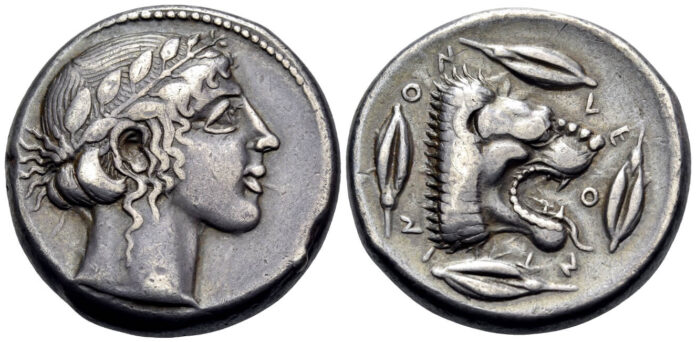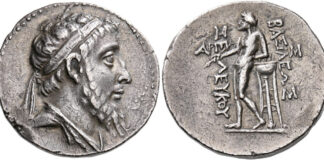Alan Walker Reviews Obolos 17
Yes, indeed, Obolos 17 was a very successful sale! Starting at 15:00 CET and going on for hours until the last lot closed, the 978 lots of the sale, which had a total Starting Price of 153,290 CHF hammered for a total of 359,630 CHF, with 96.93% sold! There were 579 different bidders who made no less than 5,604 bids. These are very nice results – for us, for the consignors, and for the new owners!
But now, here are some interesting results:
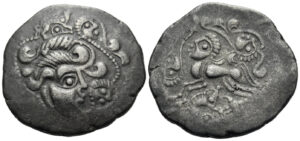
- Lot 2: A billon stater of the Osismii, which had a Starting Price of 100 CHF – it sold for 1,000 CHF!
- Lot 42: A nicely toned Metapontum with a starting price of 200 CHF went for 1,013 CHF – one can see why!
- Lot 63: The Rhegium tetradrachm that has a pedigree to the SKA Berne sale of 1985 (Starting price: 2,000) – it sold for 5,500 CHF.

- Lot 71: The Leontini tetradrachm (Starting price:750 CHF) has a pedigree going back to the Knobloch sale of 1970 – it went up to 3,800 CHF!
- Lot 80: This fascinating double-struck didrachm from Segesta with a starting price of 500 CHF was highlighted in the last newsletter since I thought it was most interesting and intriguing: so did quite a few other people – it sold for 3,000 CHF!
- Lot 140: The coinage of Alexander, with its myriads of symbols, letters, and monograms that appear on gold staters, as well as on silver tetradrachms and drachms, is a particularly favoured area for collectors. This is especially true because the late Martin Price’s superb catalogue of these coins (also serving as a catalogue of the holdings of the British Museum) gives us a perfect guide to what exists. This explains why lot 140, an apparently unpublished tetradrachm of Alexander, probably from an uncertain mint in Macedonia, flashed up to 1,100 CHF! There were 15 bids on it…
- Lot 215: Corinthian and Corinthian-type staters are equally popular because of the great variety of symbols they bear. Thus, lot 215, a Corinthian example, went for 1,500 CHF, greatly exceeding its starting price of 250 CHF!
- Lot 262: A little coin from the city of Larissa Phrikonis in Aeolis had a starting price of 50 CHF (there are six pieces in the Kayhan collection, SNG Turkey 1, 2, 1181-1186, but none are even close to being as nice as this one): it went for 320 CHF!
- Lot 284: Ephesos drachms are very popular when they are attractive like the ones we had in Obolos 17. Lot 284, starting price 100 CHF, went all the way up to 800 CHF! One curious factor on the reverse, which we must have thought was a form of striking fault, looks like a little blob in the exergue under the palm tree: it really looks like it is actually meant to be a fish! Could this be? It would be an instant article for someone!!
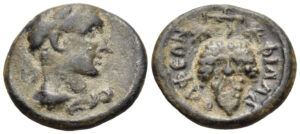
- Lot 466: The little (16 mm) hemiassarion from Philadelphia in Lydia had the modest starting price of 50 CHF, but it also has the extraordinary reverse type of a bunch of grapes with the features of Dionysos. So, naturally enough, after 25 bids it reached a hammer price of 900 CHF!!
- Lot 651: Particularly exciting because of the year in which it was struck at an Imperial mint in Thrace or Bithynia: 79 AD. That was the year of the great eruption of Vesuvius which destroyed Pompeii, it realized 1,400 CHF.
- Lot 658: The very rare denarius (starting price: 100 CHF) comes from an American collection and was previously in a Finnish one. It is virtually impossible to find – thus, it soared up to 1,500 CHF!
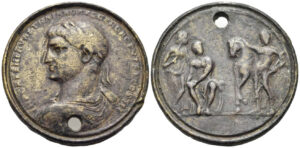
- Lot 670: To be quite honest, I have never really liked Roman contorniates: while most can be extremely interesting, and they are truly evocative of the struggle between the pagan past and the Christian present, they are, for me at least, rather an “acquired taste”. But for others, as one might expect, they are tremendously exciting. Produced in Rome during the later 4th and 5th centuries, probably meant as new year’s gifts to be distributed by the old families of the senatorial elite, they must have been viewed by some contemporaries as being extremely provocative. After all, it was in just this period that increasingly fanatical monks (especially in Egypt) and ordinary believers actually began breaking into houses to search out and destroy what they considered to be blasphemous pagan symbols, whether sculptures, paintings and the like. They also burnt immense numbers of written works – books, scrolls, letters – which they deemed were guilty of pagan thought. In fact, it has been increasingly suggested by scholars that the loss of knowledge characteristic of the European Dark Ages was not just caused by the barbarian invasions and the concomitant sacking and burning of cities and settlements, but by fanatically religious Romans themselves. One of the many interesting factors about the contorniates is the contrast between the often naturalistic artistic style their types display, as compared to the kind of hieratically static style used for contemporary coinage. In any event, the obverse of this piece bears a portrait of Trajan, accompanied by an appropriate legend, which is basically little different from one on one of Trajan’s own coins. As for the reverse, it has nothing to do with the style of the 4th/5th century: it harks back to the mid 2nd century and would be perfectly at home as the reverse of an Antonine medallion. The abundant wear on this piece, as well as the piercing, shows that it clearly must have circulated for a considerable time, most likely as an ornament or pendant, very probably on into the early Byzantine period. It was almost certainly found in Asia Minor. And people really do like it: given a starting price of 200 CHF, lot 670 shot up to a final price of more than 10x that – 2,200 CHF!
- Lot 842: Finally, another specialist surprise: an apparently unpublished and unknown trachy of Manuel Comnenus-Ducas, despot of Thessalonica (1230-1237). Not the best of coins in condition, but of the greatest rarity: it was given a starting price of CHF 50 and our assumption that “the market will figure out what it is worth…” Well, the market did: it received 25 bids from a number of very serious bidders, and it soared up to 2,400 CHF! By the way, the consignor of this coin thought it was interesting but was probably only worth putting in a multiple lot…we thought differently…
All lots of Obolos 17 can be found on the website of Nomos.



